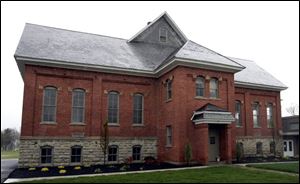
Developers apply urban touch to historic school in Findlay
11/20/2005
Jim Ott, of the development company, and Gwen Garrett, the design consultant, show off one of the units in the 1957 addition to the Victorian-era former Adams School.

Jim Ott, of the development company, and Gwen Garrett, the design consultant, show off one of the units in the 1957 addition to the Victorian-era former Adams School.
FINDLAY - It has taken longer than expected, but the renovation of the former Adams School into residential units is moving ahead, and its developers are showing them off to potential buyers.
But is a town like Findlay, with strong neighborhoods of single-family homes, ready for condominiums and urban lofts in a Victorian-era school that is on the National Register of Historic Places?
"It's so unique, but the project is still at the point that I don't know whether we need it or not," said Lynn Sopher, president of the Heartland Board of Realtors.
Jim Ott and others at KG&R Development Corp. in Tiffin are betting that Flag City USA is ready for a cutting-edge renovation of an old school into condominiums and lofts, priced starting at $74,900.
"We're trying to provide a little more modern kind of residential living space, which happens to be inside an old building," said Mr. Ott.
Said Gwen Garrett, the independent consultant recruited from Fort Lauderdale to design the project's 19 dwellings: "We wanted units with more of an urban feel. We wanted something different."
That feel includes a palette of whites, grays, and creams, such as on the former gym's cement block walls in one unit, as well as ceramic tile floors.
The designers kept original glass block windows and installed new windows below them.

The is on the National Register of Historic Places.
The school is on Washington Street, just west of downtown.
Potential customers, the developers thought, would be young professionals moving to town to work at one of the large corporations, such as Marathon Oil or Cooper Tire & Rubber Co., as well as international students enrolled in graduate programs at the University of Findlay.
More recently, the developers said, buyers also could be retirees who may want maintenance-free living or a summer residence in northwest Ohio.
Asked to describe the housing market in Findlay, Ms. Sopher, the Realtor board president, said overwhelmingly it is buyers wanting traditional houses, with a strong emphasis now on new construction.
Of 448 properties for sale in the area, 372 are single-family homes.
"You don't really see a lot of condo construction so I don't think there's anything similar in town to what they're doing," she said.
It took KG&R, which specializes in historic restorations, 18 months to get the school listed on the historic registry, which allowed it to get a 20 percent tax credit.
The process was longer and more frustrating than anticipated, Mr. Ott explained. Preservation experts were just as concerned with the interior renovation plans as those to keep the facade of the original school, built in the late 1880s.
"You've got to balance keeping that interior historic flavor against what people are really going to want to live there," he said.
Mariangela Pfister, of the Ohio Historic Preservation Office, which handled the company's request to be placed on the register, said she was most concerned with retaining the building's large corridors and sweeping front steps, a reminder that it was a school.
The former school was one of nine four-room schools built in Findlay in 1888 and 1889 to handle the population explosion that resulted from the discovery of natural gas in the area. A one-story addition was built on the east side in 1957. The building was an elementary school until 1981 and a vocational training center from 1982 to 1996, when it was closed.
Many developers use the federal tax program because it allows them to deduct 20 percent of their rehab costs on their federal income tax returns when they turn a building into an income-producing project, said Martha Raymond, a department head in the state's preservation office.
"If you can repair a historic system you should do it," she said. "If you can't, due to its deterioration, then you replace it, but you replace it to match what's there."
Now called Alexander Place I, the former Adams School eventually will have four one-bedroom units, each with 885 square feet and priced $74,900 to $89,900. Three two-bedroom units, with 1,150 to 1,350 square feet, will be priced $109,000 to $139,000, and four two-bedroom lofts, with roughly 1,400 square feet each, are to be priced to start at $139,000.
To use the rest of the grounds, the developers have built four two-unit residential buildings. Each unit has 1,400 square feet a one-car garage, priced $129,000 to $139,900.
Findlay has had only two projects in recent years in which developers took historic buildings and rehabbed them into residences. Both featured rental units in downtown buildings.
Jim Heck was one of the original investors who in 2002 transformed the historic downtown Rawson Building into retail space on the first floor, eight loft apartments on the second and third floors, and offices on the fourth.
The rental units are 850 to 1,200 square feet and are priced at $750 to $1,200 a month. They have attracted singles and married couples.
"The people who are attracted to the Rawson Lofts come from out of town, from a bigger city where this kind of thing is available, and they thought it was unique," said Mr. Heck, who runs a rental property business.
The Adams project has a market, he said.
"It's like its own compound back there," he said. "It's a great adaptive reuse of that building, and I applaud the guy for having the nerve to do it."
Russell Rogerson, executive vice president of the Findlay-Hancock County Community Development Foundation, is confident there will be enough buyers.
"This type of housing is traditionally known as a large metro type concept but the two earlier projects have proven it does work in Findlay," he said.
Contact Mary-Beth McLaughlin at: mmclaughlin@theblade.com or 419-724-6199.